Diagnosing Climate Adaptation Constraints in Rural Subsistence Farming Systems in Cameroon: Gender and Institutional Perspectives
Abstract
1. Introduction
2. Materials and Methods
2.1. Study Area
2.2. Data Collection and Analysis
3. Results and Discussion
3.1. General Characteristics of Respondents
3.2. Perception of Climate Change
3.3. Gender and Land Tenure Implications on Livelihoods in Konye
3.4. Customary Institutions and Gender Constraints in Subsistence Farming
“My wives decided on what to farm, but I prefer to plant more of cocoa because of the growing market demand. For that reason, I have asked my 3 wives not to farm on the piece of land they used because I intend to expand my cocoa plantation”(Chief Ngoe, 50, Married to 3 wives with no Legal Documentation).
“We grew up in the community to learn that it was a taboo for women to be involved in discussions concerning land issues. Land issues are reserved only for the men who determine when and where we have to farm. Although we do not complain [out of respect for our husbands or family heads], we feel that it would have been good for us to at least take part in deciding what happens to land and how it can be managed, since we are principally the ones who grow food crops for our households.”(Anna, 45 years).
“The traditional council is the decision-making body of the community. It is sacred and has [spiritual] powers. Only men are members of this council. Most of us cannot challenge any land access arrangements because we are scared of our husbands reporting us to the traditional council.”(Sonia, 49 years).
“It is difficult for us to organize [plan] our farming activities in the long term; today we are told we can farm here, and in a few years to come, we are told that the land has been sold or will be used for other purposes [small-scale palm or cocoa farms]. That is why we generally grow short-cycle crops.”(Hannah, 39 years).
“Times are changing; I guess so too is tradition. Women now own land and can farm wherever they want to. When it comes to cash crops such as oil palm, men are responsible for clearing, planting, harvesting and processing, while women assist in fruit picking and processing. However, the men make decisions about what to plant and when, what to buy or sell and at what price, and they [jointly] control the income obtained from the sale of farm produce. Alternatively, women cultivate vegetables on plots of land assigned to them by the men.”(Traditional Ruler of Konye, more than 1 wife).
4. Proposals for Building Resilience to Climate Change
5. Conclusions
Author Contributions
Funding
Acknowledgments
Conflicts of Interest
References
- IPCC. Climate Change 2007: An Assessment of the Intergovernmental Panel on Climate Change. Change 2007, 446, 12–17. [Google Scholar]
- UNEP. Africa’s Adaptation Gap Technical Report; UNEP/ROA: Nairobi, Kenya, 2013. [Google Scholar]
- Sultan, B.; Roudier, P.; Quirion, P.; Alhassane, A.; Muller, B.; Dingkuhn, M.; Ciais, P.; Guimberteau, M.; Traore, S.; Baron, C. Assessing climate change impacts on sorghum and millet yields in the Sudanian and Sahelian savannas of West Africa. Environ. Res. Lett. 2013, 8, 14040. [Google Scholar] [CrossRef]
- Qaun, J.; Dyer, N. Climate change and land tenure: FAO. Land. Tenure Working Paper NO. 2. 2008, p. 62. Available online: www.fao.org/3/a-aj332e.pdf (accessed on 30 June 2019).
- Gur, A.S.; Kimengsi, J.N.; Sunjo, T.E.; Awambeng, A.E. The Implications of Climate Variability on Market Gardening in Santa Sub-Division, North West Region of Cameroon. Environ. Nat. Resour. Res. 2015, 5, 14–23. [Google Scholar]
- Molua, E.L.; Lambi, C.M. The Economic Impact of Climate Change on Agriculture in Cameroon; World Bank Policy Research Working Paper 4364: Washington, DC, USA, 2007. [Google Scholar]
- Mcferson, H.M. Poverty among Women in Sub-Saharan Africa: A Review of Selected Issues. J. Int. Womens Stud. 2010, 11, 50–72. [Google Scholar]
- Food and Agriculture Organization. The State of Food and Agriculture. Women in Agriculture: Closing the Gap for Development; FAO: Rome, Italy, 2011. [Google Scholar]
- Bhattarai, B. Gender Equitable Adaptation to Climate Change: Interrogating Current Policy Narratives in the Nepal Himalayas; ICIMOD: Thimphu, Bhutan, 2012; pp. 15–19. [Google Scholar]
- Denton, F. Climate change vulnerability, impacts, and adaptation: Why does gender matter? Gend. Dev. 2002, 10, 10–20. [Google Scholar] [CrossRef]
- Kioboe, E.; Vinding, D.; Salazar, M.; Tuxen, V.; Munk-Ravnborg, H. Integrating Indigenous and Gender Aspects in Natural Resource Management: Guidelines for Practitioners; IGNARM: Svendborg Tryk, Denmark, 2005. [Google Scholar]
- Terry, G. No climate justice without gender justice: An overview of the issues. Gend. Dev. 2009, 17, 5–18. [Google Scholar] [CrossRef]
- Alam, M.; Bhatia, R.; Mawby, B. Women and Climate Change; Imapct and Agency in Human Rights, Security, and Economic Development; GIWPS: Washington, DC, USA, 2015; p. 72. [Google Scholar]
- Chitiga, M.; Nemarundwe, N. Policies and gender relationships and roles in the miombo woodland region of Southern Africa. In Policies and governance structures in Woodlands of Southern Africa; CIFOR: Jakarta, Indonesia, 2003; pp. 186–211. [Google Scholar]
- Doss, C.; Koverik, C.; Peterman, A.; Quisumbing, A.R.; van den Bold, M. Gender Inequalities in Ownership and Control of Land in Africa Myths versus Reality; IAAE: Washington, DC, USA, 2013. [Google Scholar]
- Kieran, C.; Sproule, K.; Doss, C.; Quisumbing, A.; Kim, S.M. Examining gender inequalities in land rights indicators in Asia. Agric. Econ. (UK) 2015, 46, 119–138. [Google Scholar] [CrossRef]
- Mwangi, E.; Meinzen-dick, R.; Sun, Y. Gender and Sustainable Forest Management in East Africa and Latin. Ecol. Soc. 2011, 16, 17–32. [Google Scholar] [CrossRef]
- Cotula, L.; Toulmin, C.; Hesse, C. Land Tenure and Administration in Africa: Lessons of Experience and Emerging Issues; IIED: London, UK, 2004; p. 50. [Google Scholar]
- FAO. Global Forest Resources Assessment 2010. Volume 147. p. 350. Available online: http://www.fao.org/3/a-i4808e.pdf (accessed on 6 July 2019).
- Jayne, T.S.; Chamberlin, J.; Headey, D.D. Land pressures, the evolution of farming systems, and development strategies in Africa: A synthesis. Food Policy 2014, 48, 1–17. [Google Scholar] [CrossRef]
- FAO. The State of Food and Agriculture: Food Security: Some Macroeconomics Dimensions; FAO: Rome, Italy, 1996; pp. 43–44. [Google Scholar]
- IFAD. Land Tenure Security and Poverty Reduction; IFAD: Rome, Italy, 2012; p. 4. [Google Scholar]
- Ribot, J.C.; Peluso, N.L. A Theory of Access. Rural Sociol. 2003, 68, 153–181. [Google Scholar] [CrossRef]
- Bradley, A. Does Communty Forestry Provide a Suitable Platform for REDD? A Case Study from Oddar Meanchey, Cambodia. 2012, pp. 61–72. Available online: https://rmportal.net/library/content/translinks/2011/land-tenure-center/ltfc-mgmt-workshop/does-community-forestry-provide-a-suitable-platform-for-redd-a-case-study-from-oddar-meanchey-cambodia/view (accessed on 30 June 2019).
- Knight, R.S. Statutory Recognition of Customary Land Rights in Africa; FAO: Rome, Italy, 2010; p. 312. [Google Scholar]
- USAID Land Tenure and Property Rights, Property rights and resource governance: Cameroon. USAID Ctry. Profile. 2011, pp. 1–30. Available online: https://landwise.resourceequity.org/record/1294 (accessed on 30 June 2019).
- African Development Bank African Development Fund Cameroon Diagnostic Study for Modernization of the Lands and Surveys Sectors; AfDB: Tunis, Tunisia, 2009.
- Ostrom, E. Institutional Analysis and Development: Elements of the framework in historical perspective. Hist. Dev. Theor. Approaches Sociol. 2010, 2, 401. [Google Scholar]
- Agrawal, A.; Perrin, N. Climate adaptation, local institutions and rural livelihoods. In Adapting to Climate Change: Thresholds, Values, Governance; IFRI W081-6: UMich, MI, USA, 2009; pp. 350–367. [Google Scholar]
- Uphoff, N.; Buck, L. Strengthening Rural Local Institutional Capacities for Sustainable Livelihoods and Equitable Development; World Bank: Washington, DC, USA, 2006; p. 81. [Google Scholar]
- AEC. Land Tenure Systems and their Impacts on Food Security and Sustainable Development in Africa; UNECA: Addis Ababa, Ethiopia, 2004; pp. 1–140. [Google Scholar]
- Robinson, B.E.; Holland, M.B.; Naughton-Treves, L. Does secure land tenure save forests? A meta-analysis of the relationship between land tenure and tropical deforestation. Glob. Environ. Chang. 2014, 29, 281–293. [Google Scholar] [CrossRef]
- Geist, H.J.; Lambin, E.F. What Drives Tropical Deforestation. Glob. Environ. Chang. 2001, 1, 136. [Google Scholar]
- Bohn, H.; Deacon, R.T. Ownership Risk, Investment, and the Use of Natural Resources. Am. Econom. Rev. 2000, 90, 526–549. [Google Scholar]
- Congo Basin Forest Partnership, The Forests of the Congo Basin. A Preliminary Assessment; CBFP: Washington, DC, USA, 2005; p. 39. [Google Scholar]
- Ndoye, O.; Kaimowitz, D. the humid forests of Cameroon, 1967–1997. J. Mod. Afr. Stud. 2000, 38, 225–253. [Google Scholar] [CrossRef]
- Wunder, S. Policy options for stabilising the forest frontier: A global perspective. In Land use, nature conservation and the stability of rainforest margins in Southeast Asia; Springer: Berlin/Heidelberg, Germany, 2004; pp. 3–25. [Google Scholar]
- Bruce, J.W.; Wendland, K.; Naughton-Treves, L. Whom to pay? Key Concepts and Terms Regarding Tenure and Property Rights in Payment-based Forest Ecosystem Conservation. Land Tenure Center Policy Brief 2010, 15, 1–10. [Google Scholar]
- Cotula, L.; Neves, B. The Drivers of Change; IIED: London, UK, 2007. [Google Scholar]
- Kumase, W.N.; Bisseleua, H.; Klasen, S. Opportunities and constraints in agriculture: A gendered analysis of cocoa production in Southern Cameroon; GIZ: Eschborn, Germany, 2010. [Google Scholar]
- KONYE-CDP-UPDATED-amended-version; PNDP: Yaoundé, Cameroon. 2013. Available online: https://www.pndp.org/documents/14_CDP_KONYE1.pdf (accessed on 6 July 2019).
- Kothari, C. Research Methodology: Methods and Techniques; New Age International: Jaipur, India, 2004. [Google Scholar]
- Kimengsi, J.N.; Ngong, J.T. Climate Variability and Cocoa Production in Meme Division of Cameroon: Agricultural Development Policy Options by Policy Options. Greener J. of Agric. Sci. 2012, 3, 606–617. [Google Scholar] [CrossRef]
- Molua, E.L. Climatic trends in Cameroon: Implications for agricultural management. Clim. Res. 2006, 30, 255–262. [Google Scholar] [CrossRef]
- Gbetnkom, D. Deforestation in Cameroon, and Poverty in the Rural Zone; University of Yaoundé II: Yaoundé, Cameroon, 2005; pp. 1–32. [Google Scholar]
- Gaymard, S.; Kay, N.; Etoundi, J. Climate Change and Beliefs in Cameroon: A Qualitative Study among Farmers in the Equatorial and Sudano-Sahelian Zones. Can. Soc. Sci. 2015, 11, 53–64. [Google Scholar]
- Fombe, L.F.; Sama-Lang, I.F.; Fonjong, L.; Mbah-Fongkimeh, A. Securing Tenure for Sustainable Livelihoods: A Case of Women Land Ownership in Anglophone Cameroon. Ethics Econ. Econ. 2013, 10, 73–86. [Google Scholar]
- Length, F. Constraints on the cultivation of Colocasia esculenta in wetland milieux in parts of the South West Region of camerroon. JAEER 2014, 1, 40–47. [Google Scholar]
- Onyeka, J. Status of Cocoyam (Colocasia esculenta and Xanthosoma spp.) in West and Central Africa: Production, Household Importance and the Threat from Leaf Blight; CGIAR: Lima, Peru, 2014. [Google Scholar]
- Rusu, T.; Moraru, P.I. Impact of Climate Change on Crop Production. Romanian Agricultural Research 2015, 32, 40–45. [Google Scholar]
- Fonjong, L.; Fombe, L.; Sama-Lang, I. The paradox of gender discrimination in land ownership and women’s contribution to poverty reduction in Anglophone Cameroon. GeoJournal 2013, 78, 575–589. [Google Scholar] [CrossRef]
- Salami, A.; Kamara, A.B.; Brixiova, Z. Smallholder Agriculture in East Africa: Trends, Constraints and Opportunities; Work. Pap. No.105 African Dev. Bank; AfDB: Tunis, Tunisia, 2010; p. 52. [Google Scholar]
- IFAD. Improving Access to Land and Tenure Security; Palombi e lanci: Rome, Italy, 2008; p. 44. [Google Scholar]
- Gyau, A.; Faith, A.N.; Fondjem-Tita, D.; Ajaga, N.; Catacutan, D. Small-holder farmers’ access and rights to land: The case of Njombé in the littoral region of Cameroon. Afr. Focus 2014, 27, 23–39. [Google Scholar] [CrossRef]
- Thomas, D.S.G.; Twyman, C. Equity and justice in climate change adaptation amongst natural-resource-dependent societies. Glob. Environ. Chang. 2005, 15, 115–124. [Google Scholar] [CrossRef]
- Adger, W.N.; Dessai, S.; Goulden, M.; Hulme, M.; Lorenzoni, I.; Nelson, D.R.; Naess, L.O.; Wolf, J.; Wreford, A. Are there social limits to adaptation to climate change? Clim. Chang. 2009, 93, 335–354. [Google Scholar] [CrossRef]
- Adger, W.N.; Barnett, J.; Brown, K.; Marshall, N.; O’Brien, K. Cultural dimensions of climate change impacts and adaptation. Nat. Clim. Chang. 2012, 3, 112–117. [Google Scholar] [CrossRef]
- Jones, L.; Boyd, E. Exploring social barriers to adaptation: Insights from Western Nepal. Glob. Environ. Chang. 2011, 21, 1262–1274. [Google Scholar] [CrossRef]
- Nelson, V.; Stathers, T. Resilience, power, culture, and climate: A case study from semi-arid Tanzania, and new research directions. World Dev. 2014, 59, 199–211. [Google Scholar] [CrossRef]
- International Monetary Fund. Cameroon: Poverty Reduction Strategy Paper; International Monetary Fund: Washington, DC, USA, 2010. [Google Scholar]
- Latruffe, L.; Piet, L. Does land fragmentation affect farm performance? A case study from Brittany, France. Agric. Syst. 2014, 129, 68–80. [Google Scholar] [CrossRef]
- Gąsiorowski, J.; Bielecka, E. Land fragmentation analysis using morphometric parameters. In Environmental Engineering, Proceedings of the International Conference on Environmental Engineering; ICEE: Vilnius, Lithuania, 2014. [Google Scholar]
- Profile, U.C.; Tenure, L.; Rights, P. USAID Country Profile Land Tenure and Property Rights; USAID: Yaoundé, Cameroon, 1985; pp. 1–53. [Google Scholar]
- Harvey, B.; Jones, L.; Cochrane, L.; Singh, R. The evolving landscape of climate services in sub-Saharan Africa: What roles have NGOs played? Clim. Chang. 2019. [Google Scholar] [CrossRef]
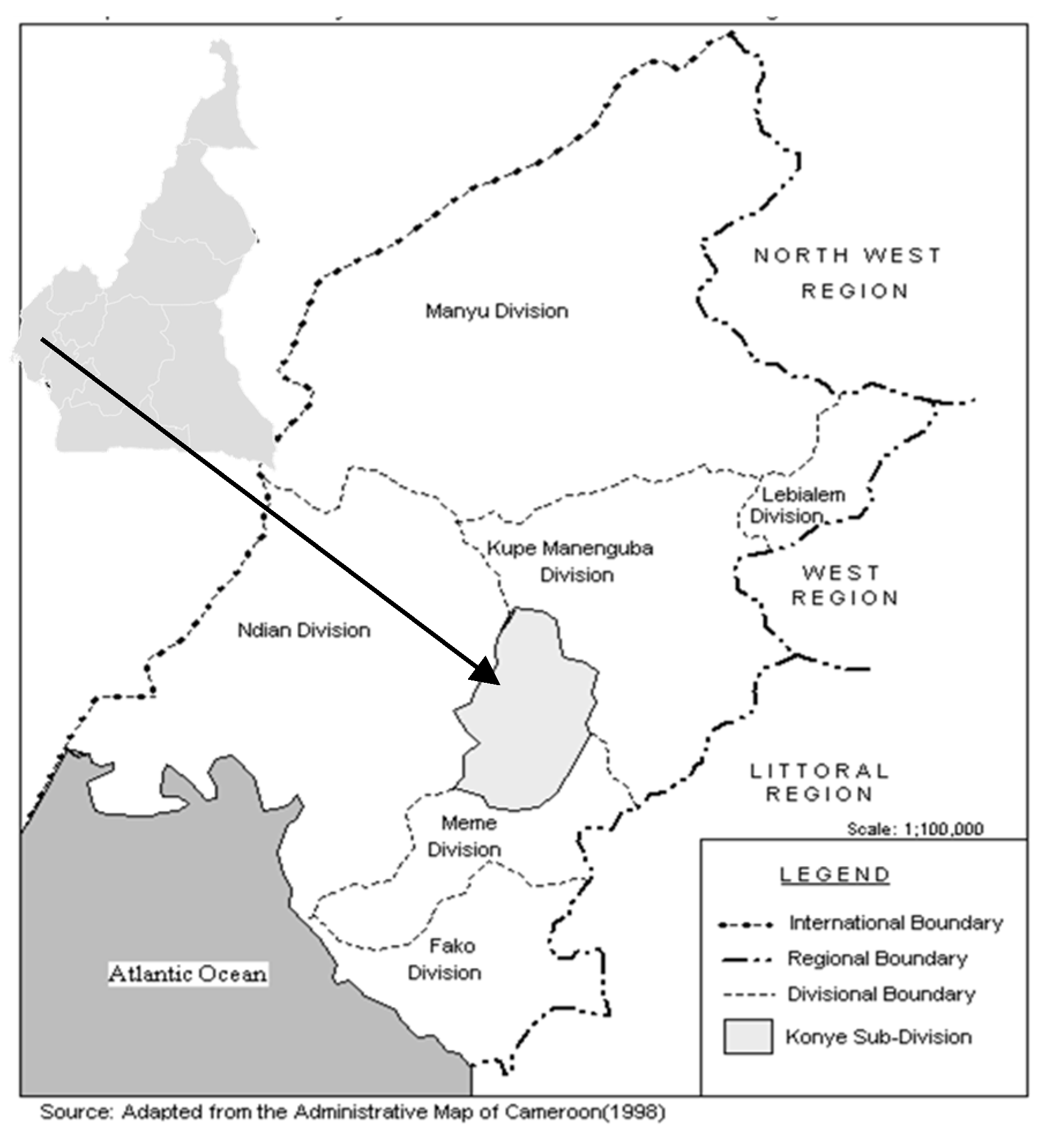
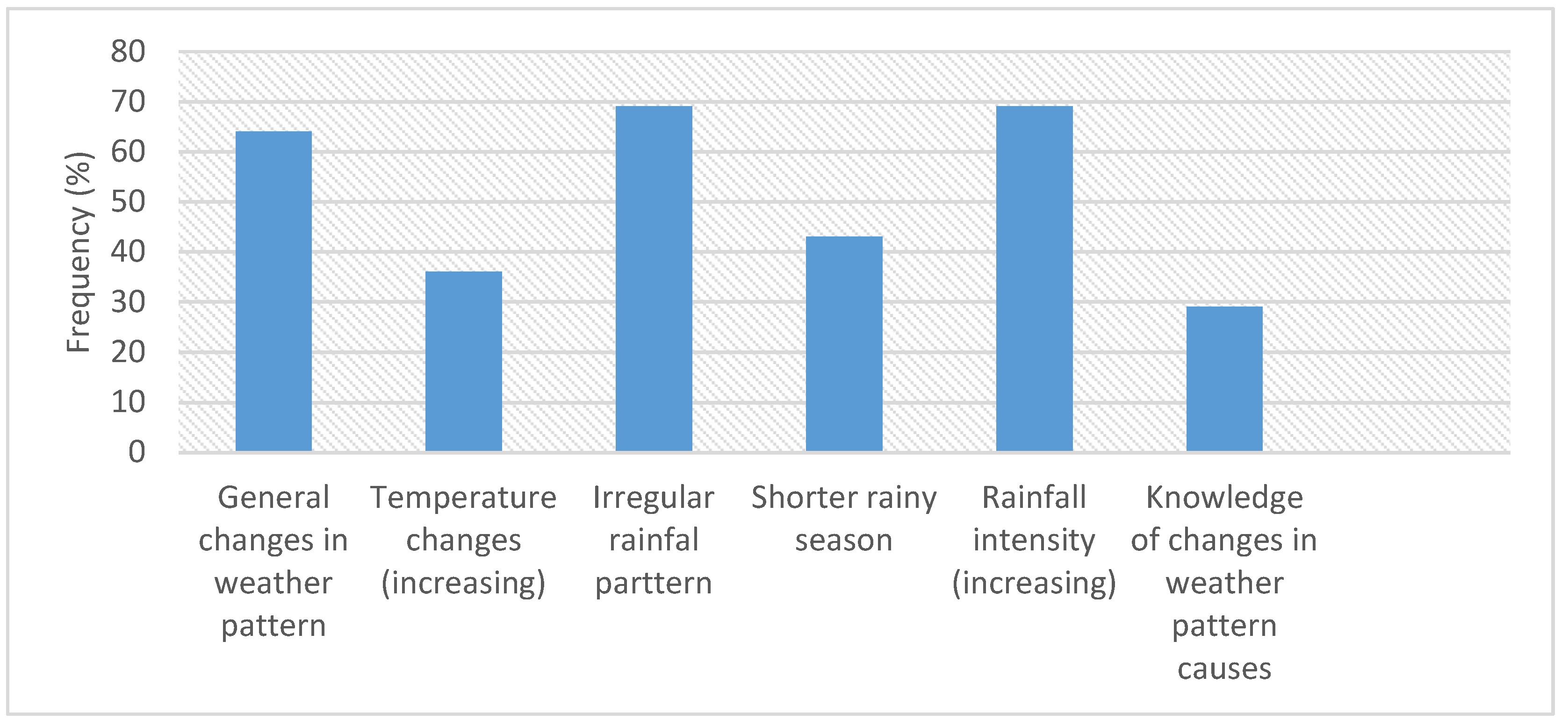
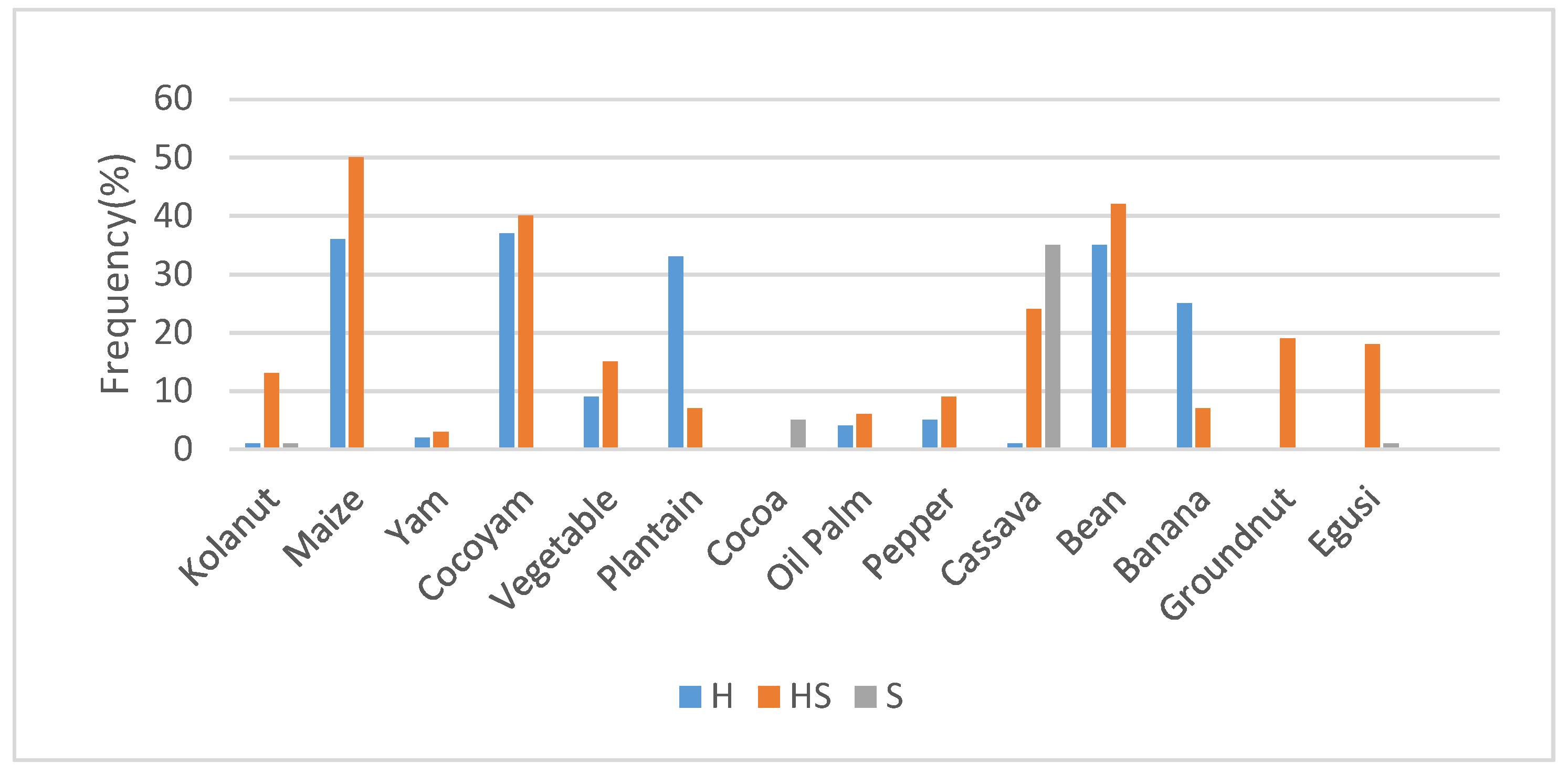
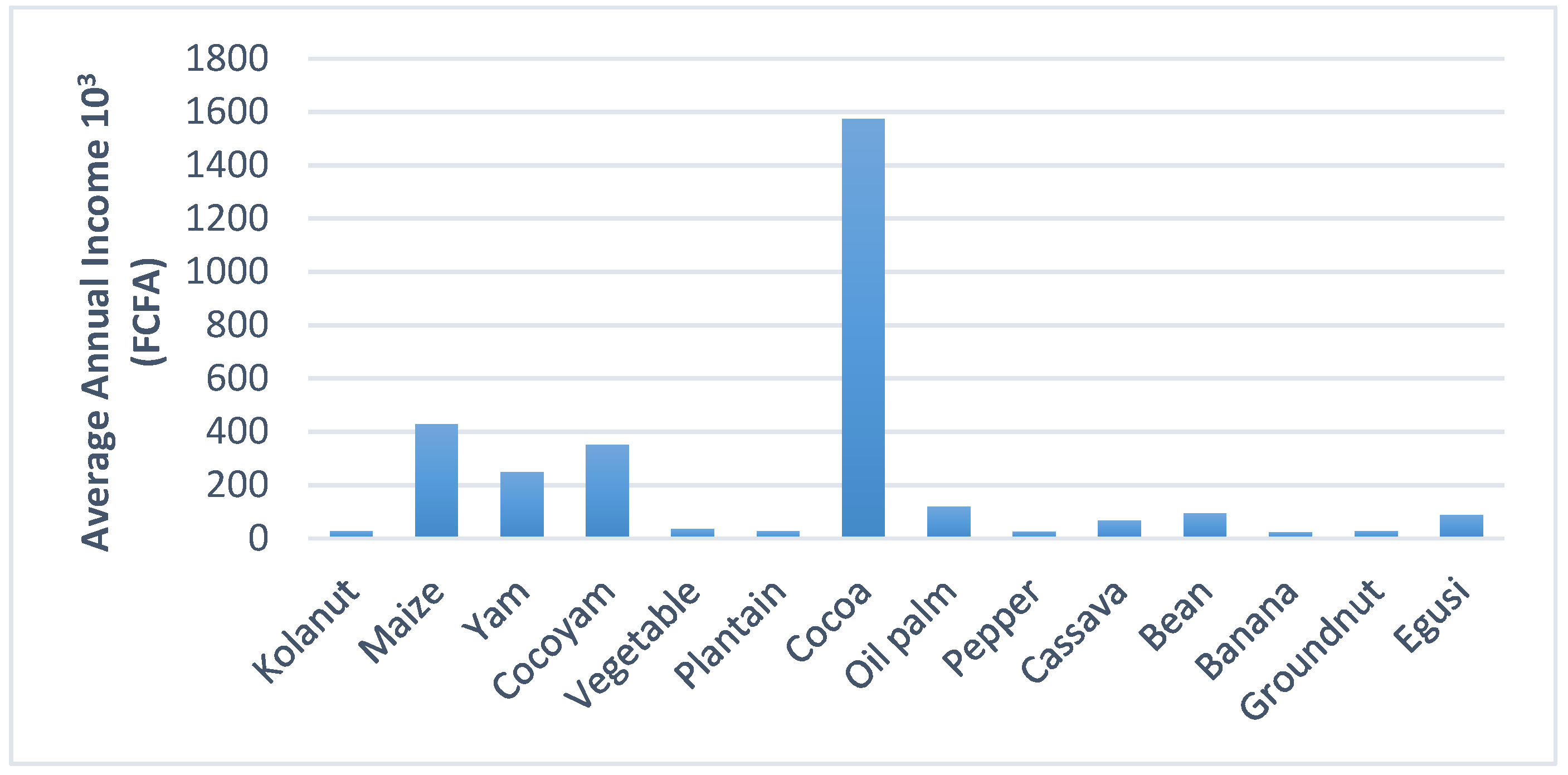
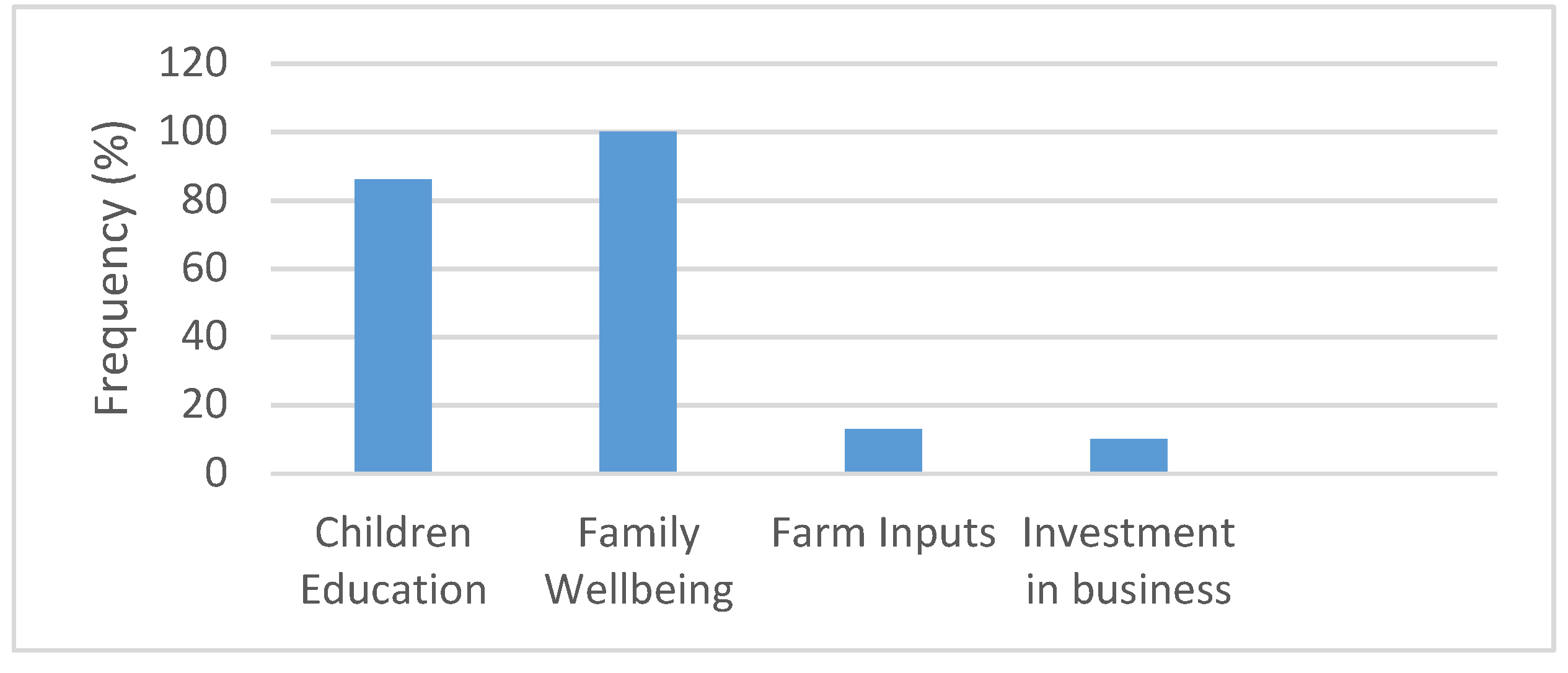
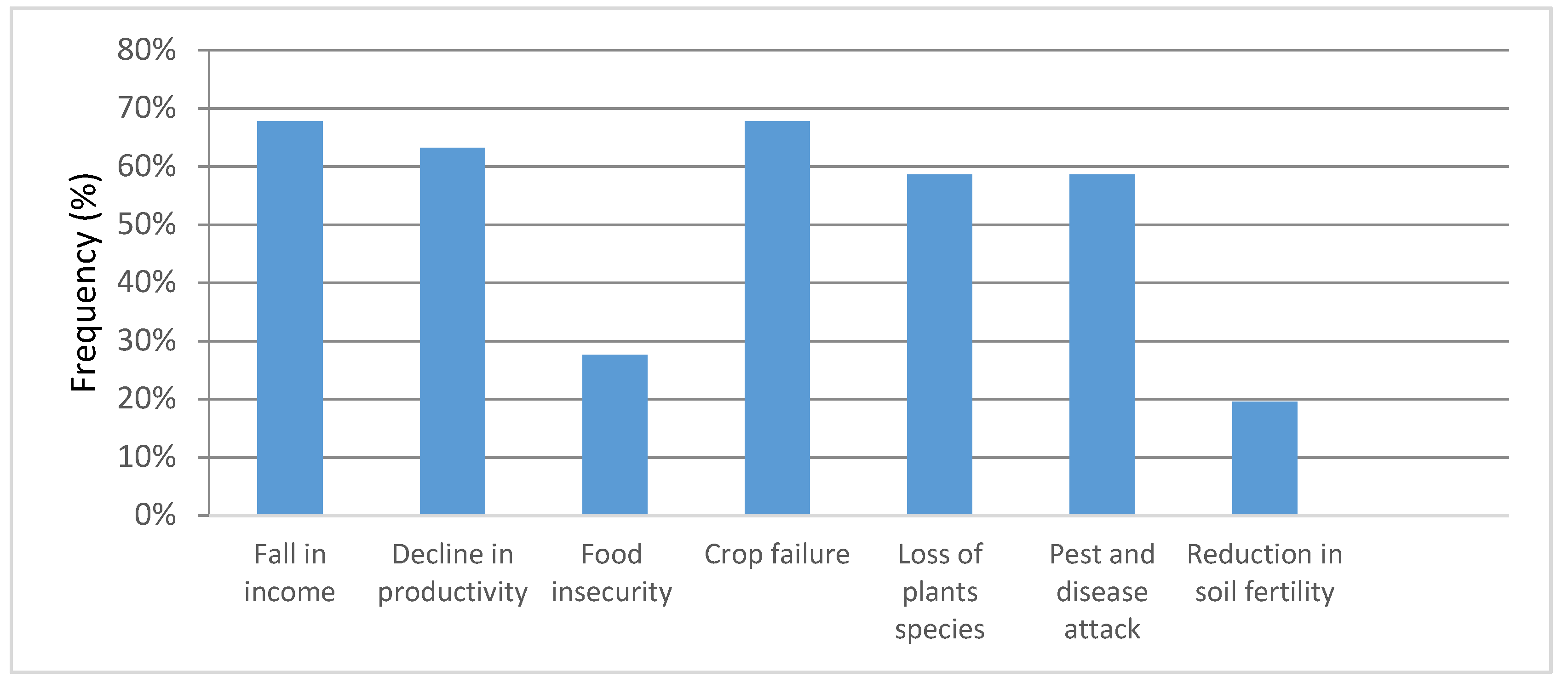
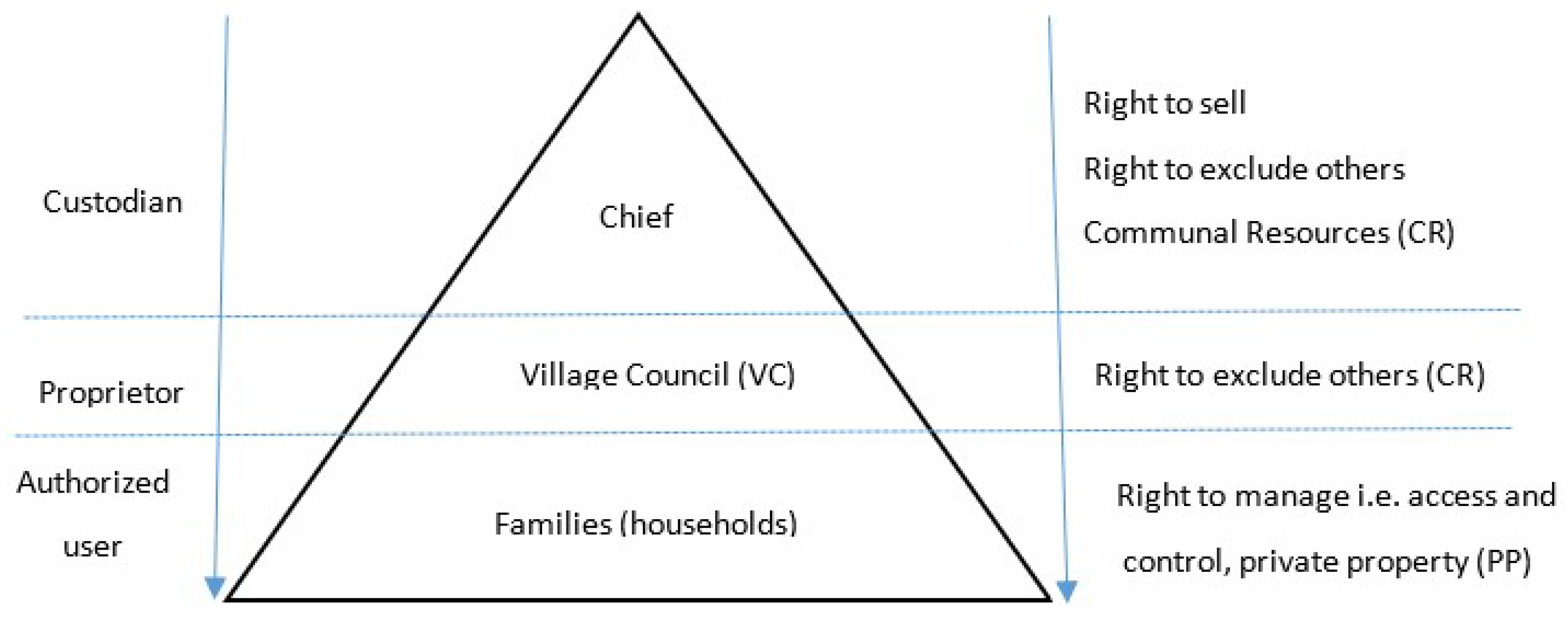
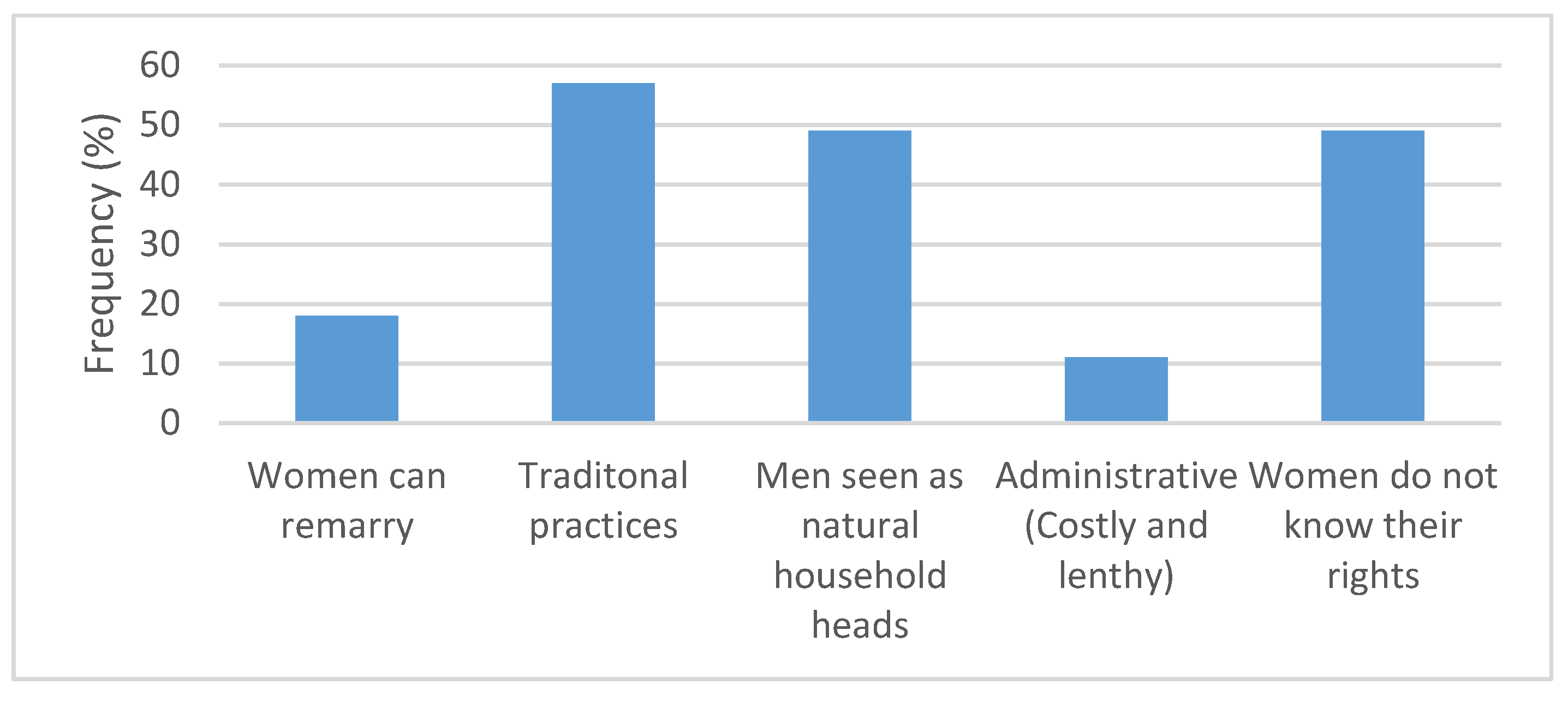
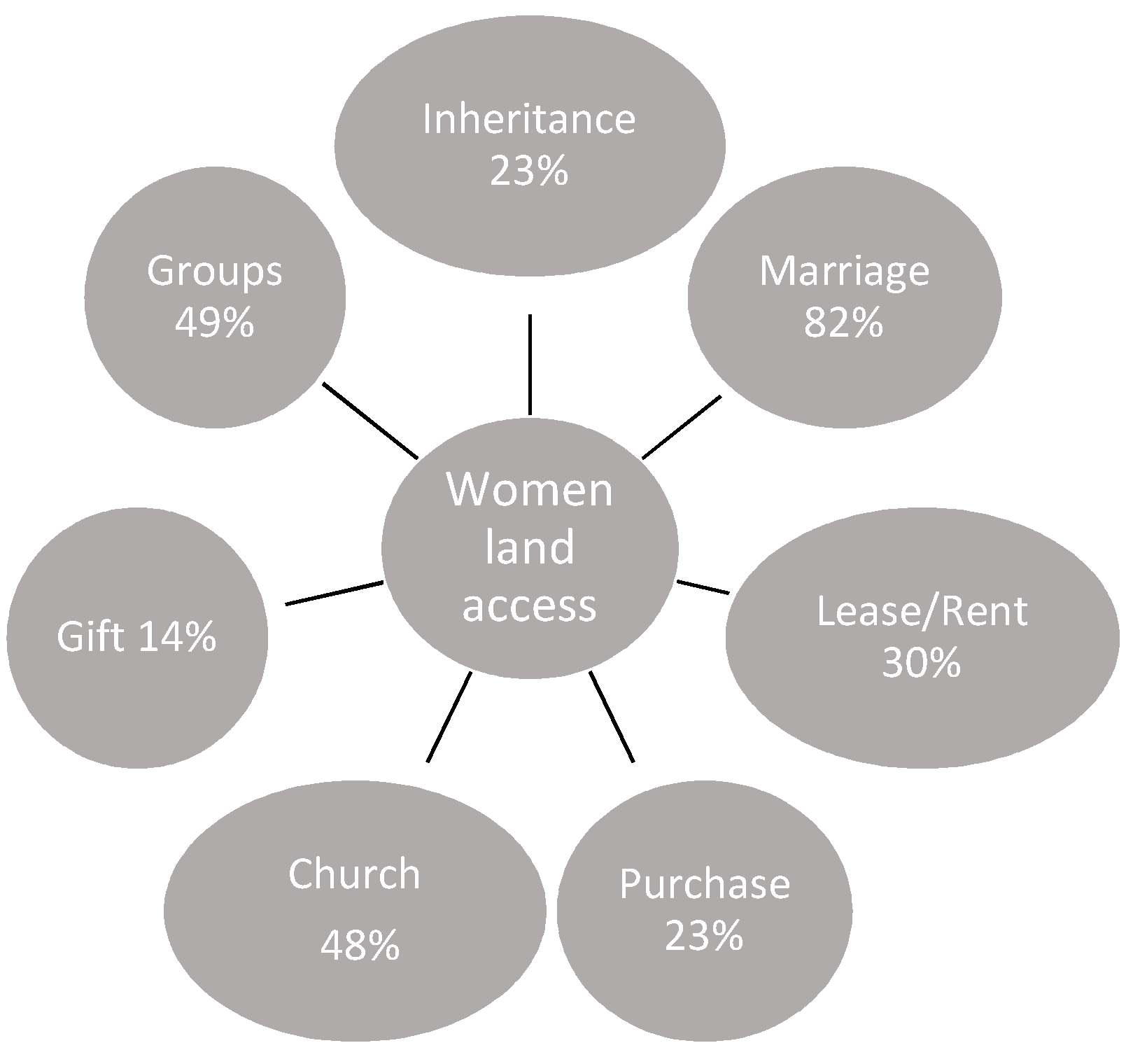
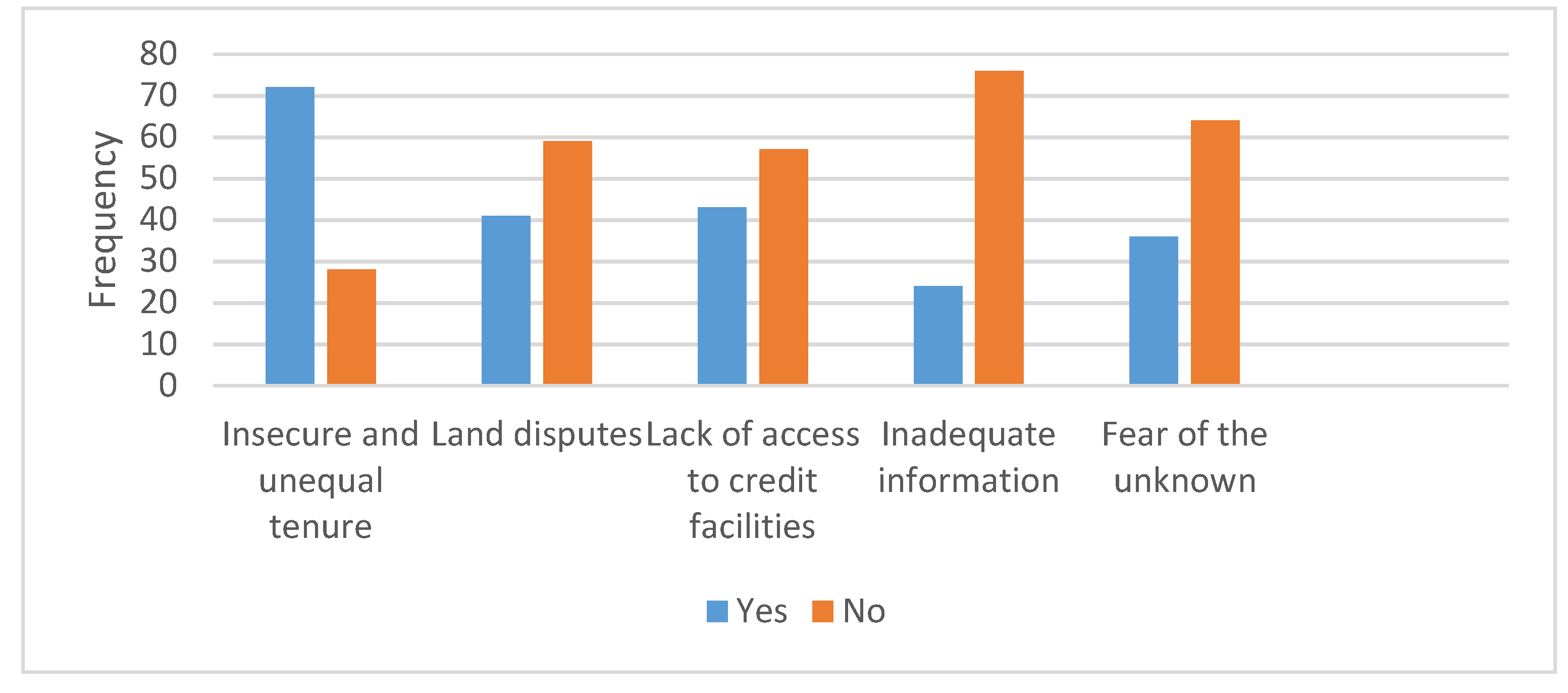
| Question | Responses |
|---|---|
| Which crops do you grow on your farm? | List of crops mentioned: (1) Kolanut, (2) Maize, (3) Yam, (4) Cocoyam, (5) Vegetable, (6) Plantain, (7) Cocoa, (8) Oil palm, (9) Pepper, (10) Cassava, (11) Bean, (12) Banana, (13) Groundnut, (14) Egusi |
| For the crops identified, explain how you use the produce. | Coded into the following categories: (1) Household use, (2) Household use and sales, (3) Sales only |
| Are you aware of any change in climate (temperature and rainfall)? | (1) Yes, (0) No |
| If yes, please answer questions (a) and (b) to indicate the manifestations of these changes: | |
| (a) Are temperatures increasing (are places getting warmer)? | (1) Yes, (0) No |
| (b) Does rainfall come earlier or later than expected? | (1) Yes, (0) No |
| From the options below indicate the applicable effects of climate change on subsistence farming: | Coded into the following categories: (1) Crop failure, (2) Reduction/loss of income, (3) Decline in productivity, (4) Loss of plants species, (5) Pest and disease attack, (6) Food insecurity and hunger, (7) Reduction in soil fertility |
| Do you have access to land? | (1) Yes, (0) No |
| Do you have a secured tenure over farmland? | (1) Yes, (0) No |
| From the list below, indicate the various sources of land access: | Coded into the following categories: (1) Inheritance, (2) Marriage, (3) Groups, (4) Lease/rent, (5) Church, (6) Purchase, (7) Gift |
| Identify the land access constraints faced by women: | Coded into the following categories: (1) Tradition, (2) Men are natural household heads, (3) Women can remarry, (4) Land title acquisition bottle necks, (5) Women are not aware of their rights |
| Does the way you access land affects the way you adapt to climate change? | (1) Yes, (0) No |
| What are your access constraints to adopt sustainable farming? | Coded into the following categories: (1) Insecure and unequal tenure, (2) Land disputes, (3) Lack of access to credit facilities, (4) Inadequate information, (5) Fear of the unknown |
| What do you do to increase yields with limited land access/control? | Coded into the following categories: (1) Proper seed/seedling preservation, (2) Change land preparation/planting dates, (3) Change of harvesting dates, (4) Use of weather resistant varieties, (5) Grow short cycle crops (early maturity), (6) Introduce pest and disease resistant crops, (7) Grow crops on wetlands |
| Do you have any off-farm coping strategy? | (1) Yes, (0) No |
| If, yes, indicate from the list below: | Coded into the following categories: (1) Migration, (2) Reduction in household food consumption, (3) Incorporation of other non-farm sources of income, (4) Adoption of non-farm income sources |
| Variables | Variable Definition | Percentage of Sample |
|---|---|---|
| Age of respondent | 1 = Less than 16 | 1 |
| 2 = 16–49 | 71 | |
| 3 = 50+ years | 28 | |
| Family size | 1 = 1–3 members | 32 |
| 2 = 4–6 members | 60 | |
| 3 = 6+ members | 8 | |
| Level of education | 1 = Primary | 44 |
| 2 = Secondary | 20 | |
| 3 = University | 3 | |
| 4 = Non formal education | 16 | |
| No formal education | 17 | |
| Marital status | 1 = Married | 79 |
| 2 = Unmarried | 21 |
| Coefficients | Significance (p-Value) | |
|---|---|---|
| Crop failure | 0.131 | 0.002 ** |
| Loss of plant species | 0.094 | 0.015 * |
| Reduction/loss of income | 0.048 | 0.535 |
| Reduction in soil fertility | 0.021 | 0.671 |
| Decline in productivity | 0.003 | 0.952 |
| Pest and disease attack | 0.009 | 0.865 |
| Food insecurity and hunger | 0.606 | 0.177 |
| Multiple R | 0.37973817 | |
| R Square | 0.144201078 | |
| Adjusted R Square | 0.123824913 | |
| Standard Error | 0.171785645 | |
| Observations | 87 |
| Value | df | Asymptotic Significance (2-sided) | Exact Sig. (2-sided) | Exact Sig. (1-sided) | |
|---|---|---|---|---|---|
| Pearson Chi-Square | 8.646 a | 1 | 0.003 | ||
| Continuity Correction b | 5.172 | 1 | 0.023 | ||
| Likelihood Ratio | 8.287 | 1 | 0.004 | ||
| Fisher’s Exact Test | 0.017 | 0.017 | |||
| Linear-by-Linear Association | 8.547 | 1 | 0.003 | ||
| N of Valid Cases | 87 |
© 2019 by the authors. Licensee MDPI, Basel, Switzerland. This article is an open access article distributed under the terms and conditions of the Creative Commons Attribution (CC BY) license (http://creativecommons.org/licenses/by/4.0/).
Share and Cite
Nchu, I.N.; Kimengsi, J.N.; Kapp, G. Diagnosing Climate Adaptation Constraints in Rural Subsistence Farming Systems in Cameroon: Gender and Institutional Perspectives. Sustainability 2019, 11, 3767. https://doi.org/10.3390/su11143767
Nchu IN, Kimengsi JN, Kapp G. Diagnosing Climate Adaptation Constraints in Rural Subsistence Farming Systems in Cameroon: Gender and Institutional Perspectives. Sustainability. 2019; 11(14):3767. https://doi.org/10.3390/su11143767
Chicago/Turabian StyleNchu, Innocent Ngiehnu, Jude Ndzifon Kimengsi, and Gerald Kapp. 2019. "Diagnosing Climate Adaptation Constraints in Rural Subsistence Farming Systems in Cameroon: Gender and Institutional Perspectives" Sustainability 11, no. 14: 3767. https://doi.org/10.3390/su11143767
APA StyleNchu, I. N., Kimengsi, J. N., & Kapp, G. (2019). Diagnosing Climate Adaptation Constraints in Rural Subsistence Farming Systems in Cameroon: Gender and Institutional Perspectives. Sustainability, 11(14), 3767. https://doi.org/10.3390/su11143767





